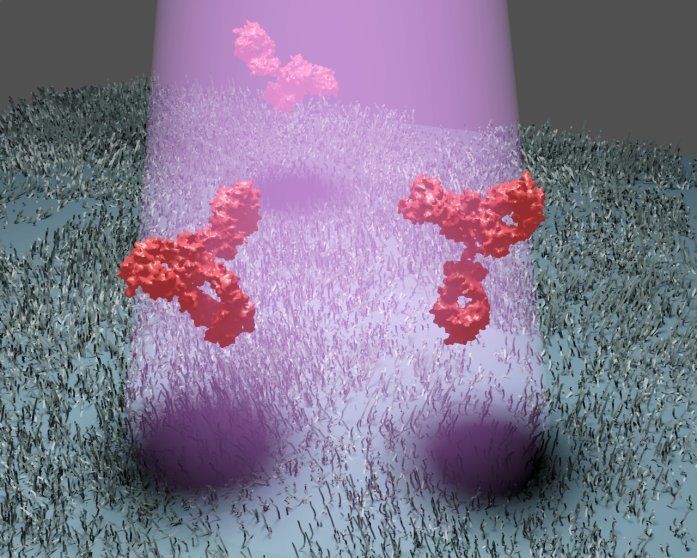The shadow of a disease
Proteins such as tumour markers can be easily and sensitively detected by their scattered light
In future, some diseases might be diagnosed earlier and treated more effectively. Researchers at the Max Planck Institute for the Science of Light in Erlangen have developed an optical method that makes individual proteins, such as the proteins characteristic of some cancers, visible. Other methods that achieve this only work if the target biomolecules have first been labelled with fluorescent tags; In general, however, that approach is difficult or even impossible. By contrast, with their method, coined iSCAT, the researchers in Erlangen are able to directly detect the scattered light of individual proteins via their shadows. The method could not only make biomedical diagnoses more sensitive, but also provide new insights into fundamental biological processes.

Researchers from Erlangen can identify individual unlabeled proteins by the weak shadow that the biomolecules produce when they scatter light. For their biosensor, the scientists use a very sensitive method to detect scattered light. In addition, they have found a way to supress the disturbing optical background noise.
© Max Planck Institute for the Science of Light
Detecting a single protein in a cell is about as easy as finding a specific car during rush hour on Germany’s motorways – without the help of registration plates. Within a cell, myriad of different proteins swarm past each other willy-nilly. Biologists are able to fish out a specific kind of protein molecule from this teeming soup and fix it on a microscope slide, but this would be of little help: when they illuminate their catch under a conventional light microscope, the proteins are masked by the background.
Vahid Sandoghdar, Director at the Max Planck Institute for the Science of Light, and Marek Piliarik, a post doc in Sandoghdar’s division, are now able to produce a much clearer image without the need for elaborate attachment of luminous markers to the target proteins. This is possible thanks to iSCAT, short for interferometric detection of scattering. The researchers shine laser light onto a microscope slide on which the relevant proteins have been captured with appropriate biochemical lures. The proteins scatter the laser light, thus casting a shadow, albeit a very weak one. “iSCAT not only promises more sensitive diagnosis of diseases such as cancers, but will also shed light on many fundamental biochemical processes in nature,” says Vahid Sandoghdar.
The scattering image of a protein is amplified and stripped of background noise
The Erlangen-based researchers have succeeded to achieve a high level of sensitivity for individual proteins by applying some tricks, and because they were not hampered by a misconception that a lot of other scientists have: “Until now it was thought that if you want to detect scattered light from nanoparticles, you have to eliminate all background light,” explains Vahid Sandoghdar. “However, in recent years we’ve realized that it is more advantageous to illuminate the sample strongly and visualize the feeble signal of a tiny nanoparticle as a shadow against the intense background light.” The researchers therefore allow the background light to interfere with the weak scattered light so that the desired signal is amplified.
However, at this stage they are still unable to detect the shadows of a single protein in the interference image, because the pattern is akin to that of a television broadcast in black and white that is distorted by a lot of noise. The interferometric detection method is so sensitive that any small roughness or contamination of the sample carrier will also cast a shadow that could in fact swamp the protein signal.
Nevertheless, this difficulty did not put off the two researchers. They have learned to eliminate the noise by applying a second trick. They take a snapshot with the iSCAT microscope not only after they have dripped a solution containing the desired protein onto the sample holder but also before. “Since most of the optical noise generated by nanoscopic irregularities of the sample do not change, we can subtract one image from the other and thus eliminate the noise,” says Piliarik. The target proteins then stand out clearly from the background as dark spots, even though the shadow of the protein is only one ten-thousandth or even one hundred-thousandth as dark as the background.
iSCAT identifies a target protein from among 2000 others
Marek Piliarik and Vahid Sandoghdar are able to detect various proteins as shadows under the microscope not only in pure solutions. They can also home in on individual proteins in mixtures containing concentrations of other proteins that are up to 2000 times greater. “The specificity of the detection method is not limited by the optics but by the selectivity of the substances used to bind the target proteins to the microscope slide,” says Marek Piliarik. As the researchers found, the amount of contrast between the protein and background depends on the size of the target particle. They even found indications that this contrast can reveal information about the shape of the protein.
“The strength of our method lies not only in the fact that it is so sensitive and that we can count target proteins in a sample,” says Vahid Sandoghdar. “iSCAT also shows us the exact position of particles.” Biologists could take advantage of this to study whether – and if so, how – different proteins interact with each other. Knowledge of protein interactions is crucial for understanding diseases and a broad range of biological processes. In future, it might be possible for biologists to use iSCAT to observe particles even smaller than proteins, i.e. RNA fragments, and watch how they interact with other substances. To this end, the researchers in Erlangen are working to further improve the signal-to-noise ratio. They know that this is possible. And they already have ideas on how to go about achieving it.




























































